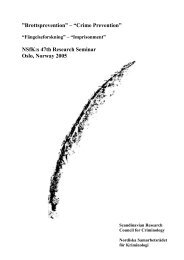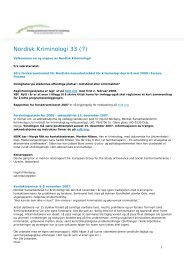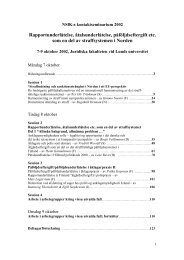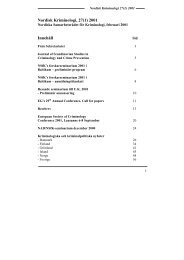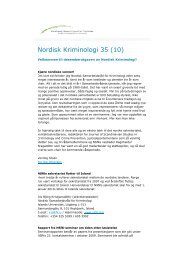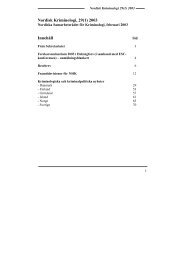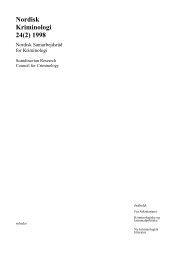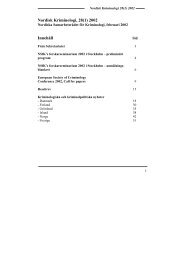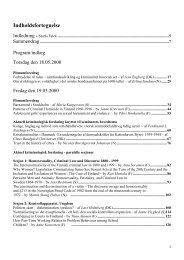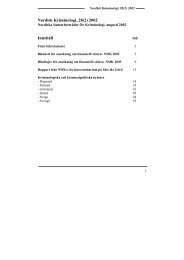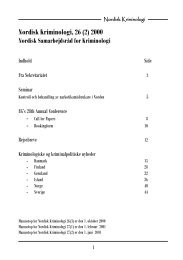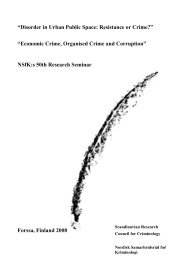Organised Crime & Crime Prevention - what works? - Scandinavian ...
Organised Crime & Crime Prevention - what works? - Scandinavian ...
Organised Crime & Crime Prevention - what works? - Scandinavian ...
You also want an ePaper? Increase the reach of your titles
YUMPU automatically turns print PDFs into web optimized ePapers that Google loves.
NSfK’s 40. forskerseminar, Espoo, Finland 1998<br />
crime which is the especially dangerous for our states given our geo-political, social and<br />
economic situation.<br />
One of the indicators of economic crime is so-called ``shadow`` economy. The data of the<br />
Ministry of Finance prove that 30-32% of Latvia’s GDP has been generated exactly in this<br />
``hidden`` sphere of economic activities. One form of the ``shadow`` economy is smuggling.<br />
Authorities estimate that smuggling of different kinds of commodities is considerable and<br />
amounts to : 50% of all meat products, 60% of precious metals, and about one third of alcohol<br />
sold in Latvia. The smuggling of food products is destroying local producers. At the same<br />
time, in 1997, only 19 persons were convicted for smuggling, 12 of them - conditionally.<br />
This is evidence that the efficiency of measures against smuggling is very low. Smuggling is<br />
favoured by following conditions:<br />
• high taxes (income, VAT);<br />
• inadequacies in legal regulations;<br />
• insufficient training and activity, as well as poor co-ordination of work in law enforcement<br />
institutions.<br />
Illegal operations with privatisation certificates (like ``vouchers`` in Russia) is another type of<br />
economic crime, causing significant damage to the state, and this significance still hasn’t been<br />
assessed. Damage by illegal operations in the process of privatisation are not estimable today.<br />
Unsolved are issues related to organised crime - illegal prostitution services and racketeering.<br />
Due to lack of time, not all matters related to organised crime are discussed, for example drug<br />
and arms trafficking.<br />
The latest feature in the Latvian crime situation in the last 10 years is the appearance of<br />
crimes with use of explosives. The average number of crimes is around 60 cases per year<br />
(1995 - 67; 1996 - 60; 1997 - 64) and more than half of them have been committed in Riga.<br />
Speaking about the latest explosions in Latvia, it must be said that the State has not<br />
recognised the commission of any terrorist acts, since the concept of terrorism is not defined<br />
in Latvia (except for highjacking of aircraft). Therefore, amendments to the Criminal law and<br />
the Criminal Procedural law are needed.<br />
The number of crimes related to the use of guns is rather unstable (table 4).<br />
The distribution of offenders (table 5) suggests that the level of recidivism is remarkably high<br />
(41.2%), as is the share of crimes committed in groups (41.0%) and crimes committed under<br />
the influence of alcohol (46.4%).<br />
The level of recidivism is also high among convicted persons (23.8%), as is the tendency to<br />
commit crime in groups (44.7%) (table 6).<br />
Contrary to police statistics, victimization survey data from 1996 show no essential difference<br />
in crime levels in the 3 Baltic States (table 7). Similarity is also observed in the reporting rate<br />
to the police (table 8). Noticeable discrepancy appears in respect to the corruption level,<br />
which is three times lower in Estonia than in Latvia (table 9).<br />
62



